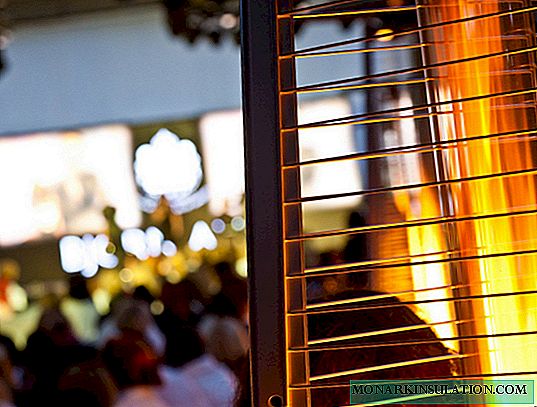
Cottage is the main source of vitamins for urban residents, therefore, as soon as the snow melts, they "fly" to create greenhouses, greenhouses, plant seedlings. The season ends again with snow, but in late autumn. And the most offensive, when the invested labor is destroyed by unexpected frosts, sudden changes in spring temperatures. Previously, they tried to save flowering trees with the help of bonfires, but today ingenious owners have discovered that a gas heater for cottages fights perfectly with the cold. Of course, it was not invented specifically for heating seedlings or trees. Infrared devices have been created for visitors to open cafes, so that they can be detained longer at tables. The season of such establishments is short, and the heaters made it possible to extend it, and thus increase profits.
And only later, practical summer residents "cast a glance" at the street gas heater, noting how many problems can be solved on the site using an infrared novelty.
What can be warmed with such a heater?
- Young trees, if an unexpected frost breaks out at night.
- Seedlings in an unheated greenhouse or greenhouse if spring heat alternates with minus night temperatures.
- Heat-loving crops that have a long ripening period, requiring warm weather until early September. But in our latitudes already in August, nights become too cold, and watermelons, melons, eggplants do not have time to ripen. Therefore, at night near the garden they put a portable gas heater.
- Purchased ducklings, chickens, etc., if they are a couple of days old.
- Tiled path, porch, steps in the winter, if they are icy. The heater will instantly melt the ice, due to which injuries occur. Moreover, such a method is more gentle for coating than breaking ice with a crowbar and shoveling.
- The recreation area on the site, the veranda, the gazebo, if the owners wanted to sit in a friendly company in the fresh air, but the temperature is not happy.
The spheres of using a gas heater in the country are so vast that each owner can add a couple more examples to this list.
Why is gas better than electric?
In addition to gas, electric infrared heaters can also be found on sale. But for summer residents it is gas systems that are more profitable. They are mobile and easily transported to the most remote corners of the site, while the electric ones are “tied” to the network, and if you need to use them far from the power source, you will have to buy a huge extension cord and pull wires through the entire country house. It takes a lot of time (especially winding!). And if there is a power outage, you can’t connect it at all.
In addition, gas is cheaper than electricity at a price, and a cylinder can always be refilled at a gas station. The gas heater has another plus in that it can accompany the owners even when traveling or on vacation outside the cottage. The men gathered for fishing in the wet morning, put a heater near them - and catch them in comfort.

Electric heaters are more popular in restaurants than in the country. In addition, not everyone in the country has electricity at all
Unit design and principle of operation
In order for the gas infrared heater to work, a gas cylinder is located in its lower part. Such systems operate on liquefied gas: either propane or butane. Ideally, it is worth looking for a model that can work on both types, because propane shows high heating efficiency in spring and autumn, when temperatures are about zero or lower, and butane in the summer.

The heat from the gas infrared heater spreads like a cone, expanding from the hood to the ground
The advantage of infrared rays is that they do not spend energy on heating the air, but act according to the solar method: they warm objects and people. This makes it warm as soon as the appliance is turned on.
No matches are needed to ignite the heater, because the system lights up according to the principle of a conventional kitchen lighter - piezo ignition. You press the button on the case - a spark is cut out, igniting the gas. The fire begins to warm a special grid, and when it warms up to the desired level, it begins to emit infrared radiation. The rays are reflected from the internal reflector and "fly out" to the street, heating a certain area and all who are in it.
Shape: pyramidal or floor lamp?
Gas heaters can be found on sale in two forms. The first is traditional, originally invented, looks like a regular floor lamp with a cone-shaped cap and an elongated leg. But if in the floor lamps the base resembles a circle, then in heaters it looks more like a tall pedestal. In this base-rack is hidden the "heart of the system" - a 25/30-liter cylinder. This amount of gas is enough for a day if the device is turned on and off. But in continuous operation, gas heaters are rarely used. As a rule, either for a couple of hours, or at night. If you install a device for nightly heating a greenhouse or flowering seedlings, then the fuel is enough for about four nights. If you use resting people to warm, then for about six to seven evenings.
The second form appeared later. It is more stylish and looks like a pyramid. In a pyramidal device, infrared rays are distributed differently. If in floor lamps they are directed from top to bottom, then heat is supplied in the form of a pillar that starts near the ground and rises by about 1.5 m. the fire is in an elongated glass bulb and is distributed evenly over the height of the entire glass. But even with strong heating of the flask there is no danger of getting burned, because on the outside the entire heater is closed with a special grill. It also protects the glass case from accidental impacts, falls, etc.

A pyramidal heater distributes heat around itself more evenly than a floor lamp
Tips for choosing a specific model
If you have a need to buy a gas model, then pay attention to the following points:
- Does the device have wheels? Heaters are quite heavy, and if you have to carry them far, it’s easier to pull on wheels than on your own hands.
- What is the security level? Ask sellers if this model is equipped with an automatic gas shut-off system in case the wind blows the flame. A good addition will be the function of turning off the feed in case of an accidental fall of the device or a strong tilt.
- How is the reflector arranged? The reflector determines the area to which infrared rays propagate. And the larger its diameter, the wider the radius of the zone that has come under warm radiation. Look for those heaters in which a sectional reflector is not a whole. If this element suddenly deteriorates, then you do not have to buy it whole, but you only need to replace the broken section.
- What is the power of the device? The wider the area you plan to heat, the more powerful the device should be. Practice has shown that summer residents choose heaters whose power = 12 kW. Their strength is enough for the normal warming up of a circle with a diameter of 6 meters. Less powerful systems for street needs are disadvantageous, while more powerful ones consume a lot of gas, although the efficiency and heating area are not too different from 12 kW.
- Convenience of adjustment. There are two types of adjustment in heaters: fixed (for strong and weak gas supply) and smooth (the summer resident can adjust the necessary level himself, taking into account the ambient temperature). The second option, of course, is more profitable.
With all its advantages, these devices are able to raise the temperature by about 10 degrees, and even then, if the street is +10 and above. The lower the air temperature, the weaker the heat level. But if you use gas heaters for residential premises, then their efficiency is higher, but the air quality is worse (combustion products enter the room!). Such systems are not recommended for prolonged use in small rooms.











